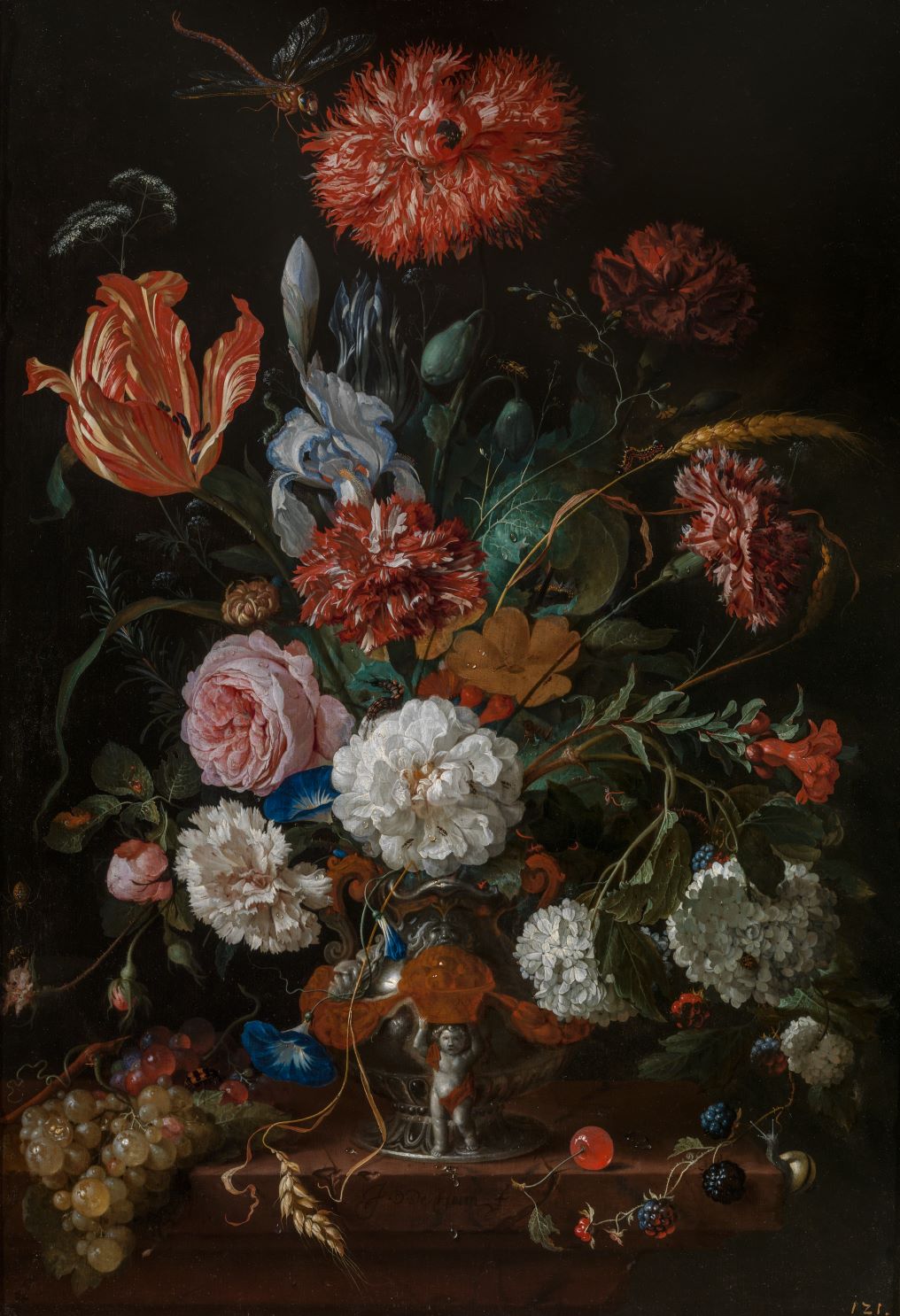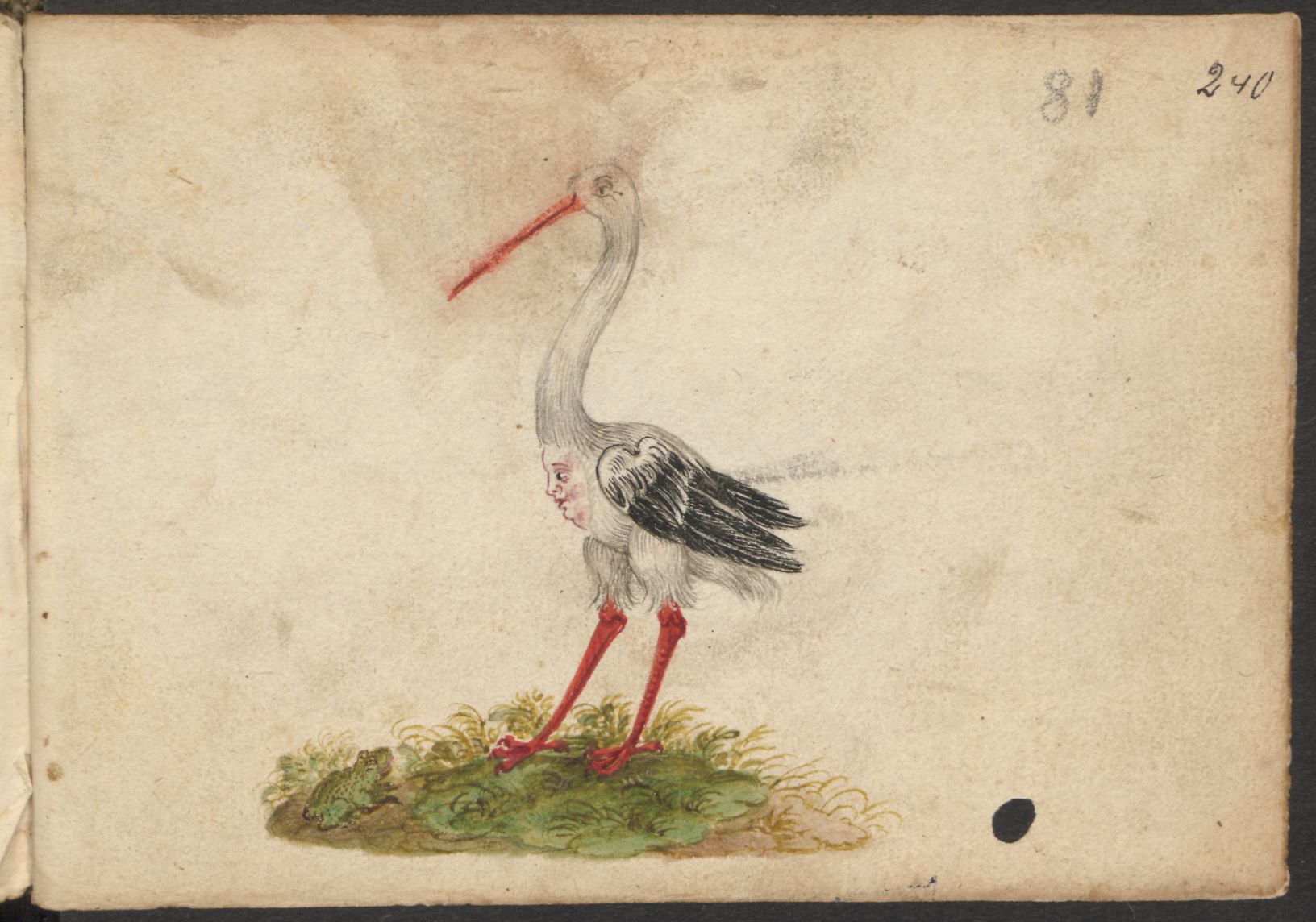Florentem. Kunstkamera
16 May 2023 – 7 January 2024

Vilnius Picture Gallery of the Lithuanian National Museum of Art holds two exhibitions, Florentem and Kunstkamera, which reflect human effort to conceive ourselves through our relationship to nature, tracing the trajectory of this changing relationship over the course of centuries together with the role of natural, especially floral motives, in human explorations of the world and one’s quest for creative inspiration.
Floral language, religion and science
The exhibition Florentem (Latin florentem means blooming, abundance, prospering) tells the story of relentless effort to know and to immortalize the elements of live nature. Fragile and predictable, yet animated and full of surprises, flora is the eternal source for human imagination, while different plants, especially when in blossom, have found ways into art and literature, assuming with time, a human-gifted power of symbolic language. Depending on context, flower blossoms included into a portrait could hint whether the sitter was a living or a dead person; plants included into the images of the Virgin Mary related to different stages of her life, while a Dutch 17th-century flower arrangement reflected the economic power of a country or a person. Importantly, a still life, reduced to the margins in the hierarchy of the genres, with time became a refuge to another kind of ‘marginalia’ – female creators. The floral world, both real and captured on paper or canvas, was one of the few ‘legitimate’ realms for female self-expression.
‘We aimed to create an engaging, visually appealing narrative how vegetation gradually inched into and took root in religious and secular canvases to flourish there, and why it was allowed such unrestricted expansion. The theme we pursued allowed us to embrace a large variety of exhibits, which exceed a hundred and a half. Visitors will encounter not only floral 17th-18th–centuries still lifes and saints surrounded by blossoms, but also views of historical Lithuanian gardens, portraits of botanists and examples of their tools, major publications, as well as such ‘unexpected’ items as a riding stick embroidered in tiny beads or a cupboard door that arrived from the Church of God’s Providence in Daugai. One of the most intriguing items on display is a boudoir that offers a kind of key-hole view into a private creating woman’s space. We hope that the exhibition and its separate elements will appeal to both specialist and public at large,’ expressed her expectations director of Vilnius Picture Gallery Dr Aistė Bimbirytė.
The exhibition is comprised in five parts, these of botanical science, of the history of gardens and parks, of plants in religious art, of symbolism and language of flowers in secular art and the significance of vegetation in the artistic and scientific female activities in 19th–century Lithuania. Each subtheme is developed through the artwork by Lithuanian and European artists.

Contemporary cabinet of curiosities: bull’s heart, seventeenth–century drawings, and an electric guitar
Exhibition–installation Kunstkamera will transport its visitors to the mysterious world of rarities in art and science. The tradition of creating cabinets of curiosities (Kunstkammer in German, meaning collections of strange art, natural objects or other rarities, and a place of keeping such) started in the 15th – 16th centuries. It was at the time, when humans started deciphering the chaos of the world and its laws, that such Naturalia and Artificialia rooms, filled with objects created by nature and humans, were started to shape. Mostly not sizeable and superficially chaotic, in fact they were arranged following a complex system conceived by their owner, the axis and Creator of that miniature world. Having lived through their gold age, the 16th –17th centuries, at some places they lingered a while. For instance, one such in Vilnius existed in the first half of the 19th century. A cabinet of curiosities on Didžioji Street belonged to Józef Antoni Kossakowski (1772–1842), a nobleman, military officer and a collector.
The most recent Kunstkammer is presented to visitors to Vilnius Picture Gallery. Of natural objects and artefacts, modern and old, the artist Aurelija Maknytė has crafted a cabinet of curiosities in the authentic interiors of the Chodkevičiai Palace (The Chodkiewicz Palace) to tell the story ‘of an inevitable and inspiring coexistence of culture and nature, where both are creators.’
The project embracing history, art and biology encapsulates the artist in her complexity. A graduate from Photography and Video Art at Vilnius Academy of Art with plenty of solo exhibitions and participations in group events under her belt, a speaker, and an artist shunning no form of expression, Maknytė has always been attracted by the fact of substantiation of seemingly natural homo sapiens’ right to subjugate nature to one’s needs. The phenomenon of curiosities cabinets in a way hints on the same topic.
Visitors to Vilnius Picture Gallery will be able to use a schematic map to inspect a bull’s heart, armour pieces from rags, a stone potato, a musical instrument from a dream, and the most ancient item on display A Stork with a Human Face on Its Breast from 1655, an allegory of fertility. Just like those ancient ones, Maknytė’s cabinet combines plenty important architectural elements, furniture pieces, drawers and boxes, and their intimate relationship with exhibits. Part of the exhibits can be touched during tours, for instance, visitors will be able to play the electric guitar manufactured from a two-stemmed pine tree that was growing under electric cables.
The exhibition includes artwork by Žygimantas Augustinas, Dovilė Bagdonaitė, Tomas Daukša, Barbora Didžiokienė, Matas Dūda, Antanas Gerlikas, Ieva Grigienė, Friedrich Grunenberg, Donatas Jankauskas – Duonis, Monika Janulevičiūtė, Juozapas Kamarauskas, Evelina Kerpaitė, Aurelija Maknytė, Mantas Maziliauskas, Petkevičienė (name unknown), Vidas Poškus, Marija Puipaitė and Vytautas Gečas, Kanutas Ruseckas, Rūta Spelskytė, Maria Šnipaitė, Gedvilė Tamošiūnaitė, Eglė Ulčickaitė and works by unknown artists.
Exhibitions like fruits of collaboration
Exhibits for the two events have been selected by Dr Aistė Bimbirytė, Dalia Tarandaitė, Ramunė Savickaitė, Joana Vitkutė and Aurelija Maknytė from a range of Lithuanian and foreign museums and private collections.
The exhibition Florentem would not have been possible without closer institutional cooperation. The lenders of the exhibition are Borys Voznytsky Lviv National Art Gallery, the National Lithuanian Museum of Art, M.K. Čiurlionis National Museum of Art, Church Heritage Museum, Samogitian Museum Alka, Šiauliai Aušra Museum, Kretinga Museum, Kaunas Diocese Museum, Rundāle Palace Museum, Rzeszów DistrictMuseum, Anykščiai Arts Centre, Vilnius University Life Sciences Centre, the Wroblewski Library of the Lithuanian Academy of Sciences, Church of God’s Providence in Daugai, Dr Kristina Sabaliauskaitė, Rūta and Rimvydas Baranauskas.
The organizers of Florentem greatly appreciate valuable help from their scientific consultant Dr Reda Griškaitė and translator Dr Raminta Bumbulytė.
Lenders of unique items to Kunstkamera exhibition are Museum of Vilnius Academy of Art, Kaunas Tadas Ivanauskas Zoology Museum, Vilnius University Geology Museum, the Wroblewski Library of the Lithuanian Academy of Sciences and individual collectors.
Both exhibitions supported from the Lithuanian Council for Culture project In natura veritas will run through 4 January 2024. The exhibitions will be accompanied by a rich programme of events, tours, public lectures and educational activities.
Organizer Vilnius Picture Gallery of the Lithuanian National Museum of Art
Project financed by Lithuanian Council for Culture
Florentem
Curators: Dr Aistė Bimbirytė, Dalia Tarandaitė, Ramunė Savickaitė, Joana Vitkutė
Architektė Simona Sigita Paplauskaitė
Designer Jonė Miškinytė
Scientific consultant Dr Reda Griškaitė
Translator Dr Raminta Bumbulytė
Partners: Borys Voznytsky Lviv National Art Gallery, the National Lithuanian Museum of Art, M.K. Čiurlionis National Museum of Art, Church Heritage Museum, Samogitian Museum Alka, Šiauliai Aušra Museum, Kretinga Museum, Kaunas Diocese Museum, Rundāle Palace Museum, Rzeszów District Museum, Anykščiai Arts Centre, Vilnius University Herbarium, Vilnius University Library, the Wroblewski Library of the Lithuanian Academy of Sciences, Church of God’s Providence in Daugai, Dr Kristina Sabaliauskaitė, Rūta and Rimvydas Baranauskas.
Kunstkamera
Curator Aurelija Maknytė
Designer Jonė Miškinytė
Translator Dr Raminta Bumbulytė
Partners: Museum of Vilnius Academy of Art, Kaunas Tadas Ivanauskas Zoology Museum,, Vilnius University Geology Museum, the Wroblewski Library of the Lithuanian Academy of Sciences.
4 Didžioji st, Vilnius, Lithuania
+370 5 261 1685
vpg@lndm.lt













